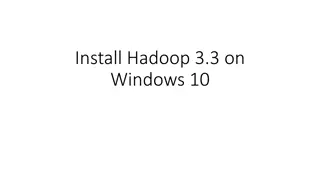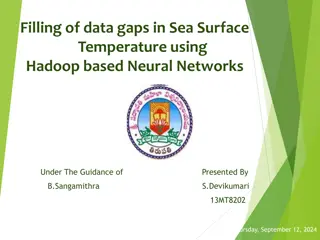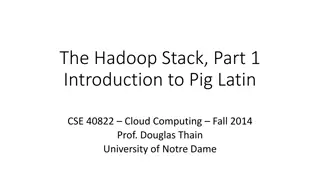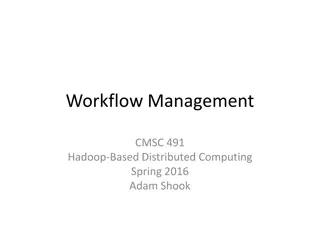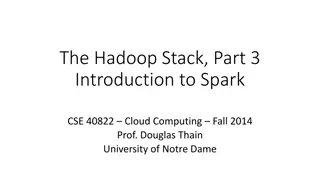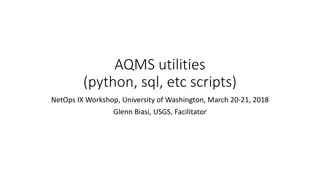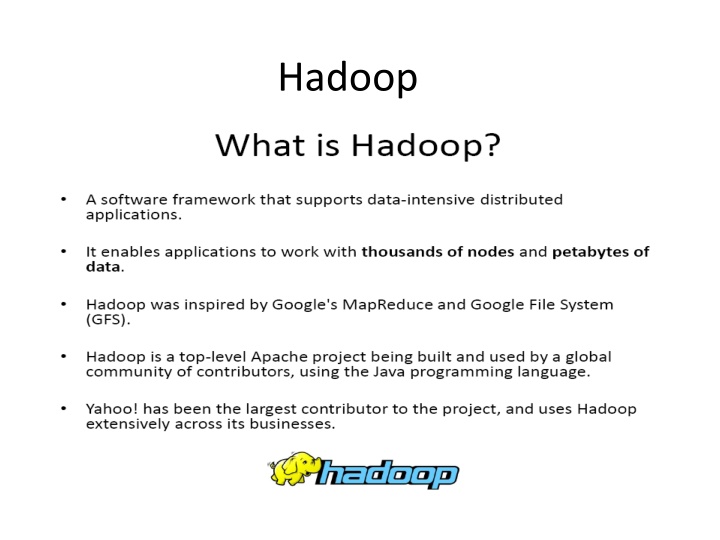
Hadoop: A Distributed Programming Framework
"Learn about Hadoop, an open-source framework for distributed applications processing large datasets. Explore its key features, architecture, daemons, and more. Discover how Hadoop's scalability, fault tolerance, and simplicity make it a popular choice for big data processing."
Download Presentation

Please find below an Image/Link to download the presentation.
The content on the website is provided AS IS for your information and personal use only. It may not be sold, licensed, or shared on other websites without obtaining consent from the author. If you encounter any issues during the download, it is possible that the publisher has removed the file from their server.
You are allowed to download the files provided on this website for personal or commercial use, subject to the condition that they are used lawfully. All files are the property of their respective owners.
The content on the website is provided AS IS for your information and personal use only. It may not be sold, licensed, or shared on other websites without obtaining consent from the author.
E N D
Presentation Transcript
Introduction Distributed programming framework. Hadoopis an open source framework for writing and running distributed applications that process large amounts of data. Key points of hadoopare Accessible Hadoop runs on large clusters of commodity machines or on cloud computing services such as Amazon s Elastic Compute Cloud (EC2 ). Robust Because it is intended to run on commodity hardware, Hadoop is architected with the assumption of frequent hardware malfunctions. It can gracefully handle most such failures. Scalable Hadoop scales linearly to handle larger data by adding more nodes to the cluster. Simple Hadoop allows users to quickly write efficient parallel code.
Introduction Hadoop consist of distributed file system, called HDFS. The Hadoop Distributed File System (HDFS) is a distributed file system designed to run on commodity hardware. HDFS is highly fault-tolerant and is designed to be deployed on low-cost hardware. HDFS provides high throughput access to application data and is suitable for applications that have large data sets. HDFS was originally built as infrastructure for the Apache Nutch web search engine project. HDFS is part of the Apache HadoopCore project.
Hadoop Daemons Hadoopconsist of five daemons. NameNode DataNode Secondary nameNode Job tracker Task tracker Running Hadoop means running a set of daemons, or resident programs, on the different servers in your network. These daemons have specific roles; some exist only on one server, some exist across multiple servers.
Name Node Hadoopemploys a master/slave architecture for both distributed storage and distributed computation. The distributed storage system is called the HadoopFile System, or HDFS. The NameNodeis the master of HDFS that directs the slave DataNodedaemons to perform the low-level I/O tasks. The NameNodeis the bookkeeper of HDFS; it keeps track of how your files are broken down into file blocks, which nodes store those blocks, and the overall health of the distributed file system. The function of the NameNodeis memory and I/O intensive. As such, the server hosting the NameNodetypically doesn t store any user data or perform any computations for a MapReduceprogram to lower the workload on the machine. it s a single point of failure of your Hadoopcluster. For any of the other daemons, if their host nodes fail for software or hardware reasons, the Hadoopcluster will likely continue to function smoothly or you can quickly restart it. Not so for the NameNode.
DataNode Each slave machine in cluster host a DataNode daemon to perform work of the distributed file system, reading and writing HDFS blocks to actual files on the local file system. Read or write a HDFS file, the file is broken into blocks and the NameNode will tell your client which DataNode each block resides in. Job communicates directly with the DataNode daemons to process the local files corresponding to the blocks. Furthermore, a DataNode may communicate with other DataNodes to replicate its data blocks for redundancy.
DataNode DataNodes are constantly reporting to the NameNode. Upon initialization, each of the DataNodes informs the NameNode of the blocks it s currently storing. After this mapping is complete, the DataNodes continually poll the NameNode to provide information regarding local changes as well as receive instructions to create, move, or delete blocks from the local disk.
Secondary NameNode The Secondary NameNode(SNN) is an assistant daemon for monitoring the state of the cluster HDFS. Like the NameNode, each cluster has one SNN. No other DataNodeor TaskTrackerdaemons run on the same server. The SNN differs from the NameNode, it doesn t receive or record any real-time changes to HDFS. Instead, it communicates with the NameNodeto take snapshots of the HDFS metadata at intervals defined by the cluster configuration. As mentioned earlier, the NameNodeis a single point of failure for a Hadoopcluster, and the SNN snapshots help minimize the downtime and loss of data. Nevertheless, a NameNodefailure requires human intervention to reconfigure the cluster to use the SNN as the primary NameNode.
JobTracker The JobTracker daemon is the liaison (mediator) between your application and Hadoop. Once you submit your code to your cluster, the JobTracker determines the execution plan by determining which files to process, assigns nodes to different tasks, and monitors all tasks as they re running. Should a task fail, the JobTracker will automatically re launch the task, possibly on a different node, up to a predefined limit of retries. There is only one JobTracker daemon per Hadoop cluster. It s typically run on a server as a master node of the cluster
Task tracker Job Tracker is the master overseeing the overall execution of a Map- Reduce job. Task Trackers manage the execution of individual tasks on each slave node. Each Task Tracker is responsible for executing the individual tasks that the Job Tracker assigns. Although there is a single Task Tracker per slave node, each Task Tracker can spawn multiple JVMs to handle many map or reduce tasks in parallel.
Hadoop Configuration Modes Local (standalone) mode The standalone mode is the default mode for Hadoop. Hadoopchooses to be conservative and assumes a minimal configuration. All XML (Configuration) files are empty under this default mode. With empty configuration files, Hadoopwill run completely on the local machine. Because there s no need to communicate with other nodes, the standalone mode doesn t use HDFS, nor will it launch any of the Hadoopdaemons. Its primary use is for developing and debugging the application logic of a Map-Reduce program without the additional complexity of interacting with the daemons.
Hadoop Configuration Modes Pseudo-distributed mode The pseudo-distributed mode is running Hadoop in a cluster of one with all daemons running on a single machine. This mode complements the standalone mode for debugging your code, allowing you to examine memory usage, HDFS input/output issues, and other daemon interactions. Need Configuration on XML Files hadoop/conf/.
Hadoop Configuration Modes Configuration core-site.xml <?xml version="1.0"?> <?xml-stylesheettype="text/xsl" href="configuration.xsl"?> <!-- Put site-specific property overrides in this file. --> <configuration> <property> <name>fs.default.name</name> <value>hdfs://localhost:9000</value> <description>The name of the default file system. A URI whose scheme and authority determine the FileSystem implementation. </description> </property> </configuration> mapred-site.xml <?xml version="1.0"?> <?xml-stylesheettype="text/xsl" href="configuration.xsl"?> <!-- Put site-specific property overrides in this file. --> <configuration> <property> <name>mapred.job.tracker</name> <value>localhost:9001</value> <description>The host and port that the MapReduce job tracker runs at.</description> </property> </configuration> hdfs-site.xml <?xml version="1.0"?> <?xml-stylesheettype="text/xsl" href="configuration.xsl"?> <!-- Put site-specific property overrides in this file. --> <configuration> <property> <name>dfs.replication</name> <value>1</value> <description>The actual number of replications can be specified when the file is created.</description> </property> </configuration>
Hadoop Configuration Modes Fully distributed mode Benefits of distributed storage and distributed computation master The master node of the cluster and host of the NameNode and Job-Tracker daemons backup The server that hosts the Secondary NameNode daemon hadoop1, hadoop2, hadoop3, ... The slave boxes of the cluster running both DataNode and TaskTracker daemons
Working with files in HDFS HDFS is a file system designed for large-scale distributed data processing under frameworks such as Map-Reduce. Store a big data set of (say) 100 TB as a single file in HDFS. Replicate the data for availability and distribute it over multiple machines to enable parallel processing. HDFS abstracts these details away and gives you the illusion that you re dealing with only a single file. Hadoop Java libraries for handling HDFS files programmatically.
Hadoop Shell commands (Basic file commands ) Basic file commands Hadoop file commands take the form of hadoop fs -cmd <args> hadoop fs ls (list the hdfs content) hadoop fs mkdir /user/hdfs/test (make directory) hadoop fs rmr /user/hdfs/test (delete directory/files) hadoop fs -cat example.txt | head hadoop fs copyFromLocal Desktop/test.txt /user/hdfs/ hadoop fs copyToLocal /user/hdfs/test.txt Desktop/ Etc
Assumptions and Goals Hardware Failure Hardware failure is the norm rather than the exception. An HDFS instance may consist of hundreds or thousands of server machines, each storing part of the file system s data. The fact that there are a huge number of components and that each component has a non-trivial probability of failure means that some component of HDFS is always non-functional. Therefore, detection of faults and quick, automatic recovery from them is a core architectural goal of HDFS.
Assumptions and Goals Streaming Data Access Applications that run on HDFS need streaming access to their data sets. They are not general purpose applications that typically run on general purpose file systems. HDFS is designed more for batch processing rather than interactive use by users. The emphasis is on high throughput of data access rather than low latency of data access.
Assumptions and Goals Large Data Sets Applications that run on HDFS have large data sets. A typical file in HDFS is gigabytes to terabytes in size. Thus, HDFS is tuned to support large files. It should provide high aggregate data bandwidth and scale to hundreds of nodes in a single cluster. It should support tens of millions of files in a single instance
Assumptions and Goals Simple Coherency Model HDFS applications need a write-once-read-many access model for files. A file once created, written, and closed need not be changed. This assumption simplifies data coherency issues and enables high throughput data access. A Map/Reduce application or a web crawler application fits perfectly with this model. There is a plan to support appending-writes to files in the future.
Assumptions and Goals Moving Computation is Cheaper than Moving Data A computation requested by an application is much more efficient if it is executed near the data it operates on. This is especially true when the size of the data set is huge. This minimizes network congestion and increases the overall throughput of the system. The assumption is that it is often better to migrate the computation closer to where the data is located rather than moving the data to where the application is running. HDFS provides interfaces for applications to move themselves closer to where the data is located.
Assumptions and Goals Portability Across Heterogeneous Hardware and Software Platforms HDFS has been designed to be easily portable from one platform to another. This facilitates widespread adoption of HDFS as a platform of choice for a large set of applications.
Assignment Interrelation between hadoopand Amazon cloud.


